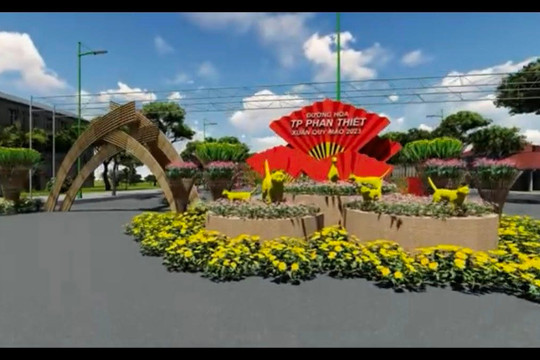
The procession to Thay Thim's palace.
Background and formation of Thay Thim palace relic
According to local history, the land of Tam Tan (today's Tan Tien commune) has been inhabited since the early 19th century. After Gia Long won the throne, the wave of exiles from the South Central region followed by sea to the south, reclaiming land and establishing villages. The river mouth of the Ma Ly (Phan River) opens to Tam Tan, creating a bay with calm waves and a mild climate all year round. Thuan Trinh - Tam Tan station is moved and connected with Thuan Ly station (Phan Thiet) and Thuan Phuong station (Phuoc Loc) on the old route of Tuy Ly district, Ham Thuan district, Binh Thuan province. Since then, many cultural characteristics of the central region (Quảng area) have been integrated and gradually integrated with natural conditions and local community life.
Facing the impact of natural phenomena, and dangerous diseases, the appearance of Thay Thim through legend in folklore, mysterious and sacred as a righteous god of suffering and healing, became the peaceful and trusty support in the people's spiritual life in the new land. That is more towards the roots, family trees, and religious practices of the ancestors. The image of the deity Thay Thim is admired by the villagers who worshiped and built a palace to worship and has a separate god to patronize the whole community; therefore it is also considered the God of Thanh Hoang of Tam Tan village. The feature here shows the conviction that it is both an intangible culture and a tangible culture, etc, creating a very specific cultural value of the locality.
Although they had left their homeland due to the chaos of life, their customs and lifestyle had still deeply pervaded in their the exiled. The typical culture in the rituals of Thanh Hoang, local Gods, Nghinh Ong Nam Hai,etc from the beginning, has changed due to many limitations of difficult economic circumstances, and sparse population. However with the folk rituals according to the spiritual beliefs of Thay Thim palace since the Tam Quy Association foundation (before 1969); the basic rituals were restored from the characteristics of the ancestral land, and the homeland of Quang was harmonious and suitable for the local beliefs and customs.
The identity of the ceremony and festival of Thay Thim Palace
Based on the event of the first construction of Thay Thim Palace at the end of 1879 (the 32nd Tu Duc emperor) through the inscription on the purlin of the main hall, there is still " Kỷ Mão niên, thập nhị ngoạt, thập nhị ngũ nhật cấu tạo” (The year of Cat, twelve crosses, twelve five days of structure). However, in fact, before that, Tam Tan village had exiled people from all over the world, gathered in this land. The place-name Tam Tan is the origin of 3 villages Tan Nguon, Tan Quy, and Tan Hoang in Tuy Dinh district, Ham Thuan government. After a terrible flash flood devastated the estuary of the Maly River (Nganh) and moved up, creating a new way towards Ba Dang - White Cave. Three villages merged to become Tam Tan village (selecting three words Tan as a place name) including the land of two communes Tan Hai and Tan Tien this day. The Master Thim shrine exists in a primeval oil forest called Bau Cai and not far from the palace are two graves of Master Thim. At the bottom of the two graves is a small tomb of Bach Ho and Hac Ho in Bau Thong.
The shrine has a simple thatched roof and wooden walls, but it is always covered by the birds as if to immerse themselves in sacred air and be at peace in a quiet, dark forest. In 1975, Vietnam was completely liberated, under the new regime, the Tam Quy Association built an operating model on the basis of a traditional and folk belief organization. That meets the spiritual needs of the people, and social community and building a routine of activities and rituals of human significance with cultural values according to the Association's Charter and within the framework of the law. Besides the task of preserving the cultural and historical relic of Thay Thim palace, the Tam Quy Association also sets forth the principle of preserving the good national traditions and cultural identity of the ancients. Especially on the occasion of sacrifices and merit offerings of relatives and guests from all over the world, they have constantly provided support and resources for the Tam Quy Association to build, restore and repair facilities for worshiping more solemnly and respectively; Besides, contributing to sharing with society through humanitarian work, relief for poor situations, and natural disasters in the locality. These were also considered practical actions according to the moral aspirations of Master Thim during his lifetime.
The process of building, repairing, and embellishing ThayThim palace and operation spanned 143 years (1879 - 2022) with many ups and downs. Significant milestones of the development and affirmation of the effectiveness of the operation and management of the Three Quarters Association; In 1993 Decision No. 1377/QD-UBBT dated December 6, 1993, of Binh Thuan Provincial People's Committee - recognizing the landscape of Thay Thim Palace. In 1997 Decision No. 2890/QD-BVHTT dated September 27, 1997, of the Ministry of Culture and Information, recognized the architectural and artistic relic of Thay Thim Palace. In 2022, Decision No. 62/QD-BVHTTDL dated January 12, 2022, of the Ministry of Culture, Sports and Tourism, included in the "National Intangible Cultural Heritage List: Traditional Festivals - Thay Thim Palace Festival".
Since 1993, according to the request of the People's Committee of Ham Tan District and the Department of Culture, Information and Sports, the People's Committee of Binh Thuan Province has decided that Master Thim Palace becomes a "Scenic Landscape" of the province. The first step in organizing the management of Thay Thim palace was established and is the basis for promotion. This is also the result of a long time with the sincere efforts of the Board of Directors of the Tam Quy Association over the years to maintain and preserve the heritage, enlisting the attention and support of the government and at all related levels and sectors.
Until Vietnam had entered an era of change and reform in the economy, culture, and social life, in the early 90s of the last century, the Ham Tan district (including La Gi town and La Gi district) Today's Ham Tan) has made new changes and the annual traditional ceremony of Thay Thim Palace has advantages and is supported to organize a magnificent ceremony. Especially the main ceremonies: Grave excavation ceremony (January 5th), autumn sacrifice ceremony (September full moon) becomes a profound cultural and scale mark taking place in a beautiful and potential sea. The glory of the Thay Thim legend and the palace that existed for more than a hundred years, lurking under the primeval forest, fragrant with wildflowers and many miraculous herbs, etc have a strong attraction to worshipers in the province and southern provinces and cities.
The festival is elevated and associated with the general development
The festival of Thay Thim's palace, besides the traditional festivals of the year, is maintained; except for the autumn festival taking place on the full moon day of September (the 14th, 15th, and 16th). This is the biggest sacrifice ceremony of Master Thim palace every year. The ritual of offering sacrifices to the gods from the palace (Bau Thong) at dawn on the 14th, processing the spirit of Thay Thim on more than 3 kilometers journey, and arriving at the palace for the solemn entrance. On the full moon day of the festival, the worshiping ceremony is performed by Chanh worshiping. At dawn on the 16th, the ceremony of asking for birth was conducted, the main sacrifice was made, and followed by the Tuc Yet ceremony. The sacrifice is a live pig with white hair, which has been stabbed to collect a little blood and a pinch of hair (called capillary blood) according to tradition, meaning "sacrifice".
The assistant disciples brought the blood cup and placed it on the incense table for the ceremony of the Chief Priest, the Sun Gods. At the same time, at noon on the 16th is the anniversary of Sage's death anniversary with the offering of 9 trays of rice and food, showing his sincerity the gratitude "Tiền hiền khai khẩn, Hậu hiền khai cơ…”. The offerings must follow the customs of the ancients and are indispensable at the Main Hall, the tables of Kham Thay, Kham Tien Hien, Ong Ho Temple, Thanh Hoang Temple, local spirit ...
In the campus of the main hall to worship Thay Thim, the shrine of Tien Hien, the Citadel of the village, the shrines ... are decorated, solemn offerings. Next to the old banyan tree with its wide roots on the ground like an incarnation of crocodiles and pythons are showing up under the shade of cool green trees. Every year, the model design from the legend of Thay Thim is recreated with a simple thatched roof; wooden boat to remember the story of "sái đậu thành binh" that he made a boat to help fishermen; Dried gourd is associated with magical secret… so vivid. Besides, there are charity activities, food donations, and herbal medicine for everyone. The most bustling part of the festival season of September, the autumn festival, the 14th evening is the opening ceremony of the cultural and tourism festival of Thay Thim palace, which is also the official opening night of the festival to welcome visitors from all over the world. Officials at all levels of the province and La Gi - Ham Tan were present to beat the drums to begin the festival. The cultural program, theatrical performance of the night "Autumn moon from the sea" is changed every year to depict, feelings about the legendary spirituality through the image of Thay Thim in everyday life, introducing La Gi cultural colors. Therefore, the festival season of Thay Thim Palace is also considered as the peak to welcome tourists from all over the world to La Gi to both worship and enjoy the space of the wildly sea-land with "blue sea and white sand, golden sunshine”…
Currently, the Thay Thim palace festival registered in the "List of National Intangible Cultural Heritage" requires constant investment, regeneration, and enhancement of cultural identity to accompany with the community and save it for the future.
























.jpg)





.jpeg)

.jpeg)


.jpeg)


